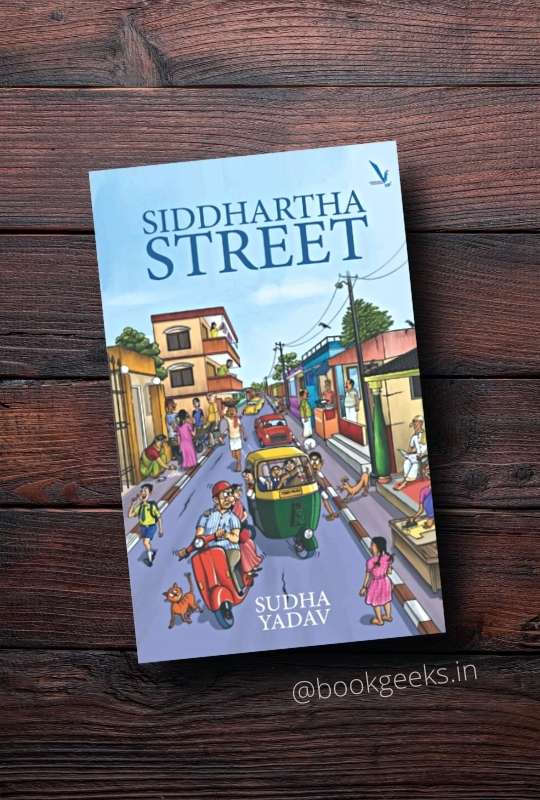PLOT: 3.5/5 CHARACTERS: 3.5/5 CLIMAX: 3.5/5 WRITING STYLE: 3.5/5 ENTERTAINMENT QUOTIENT: 3.5/5
Siddhartha Street by Sudha Yadav is a collection of short stories or rather perspective pieces from the aspect of different characters who live in the same neighbourhood.
Set in the fictional lane named Siddhartha Street, located somewhere in South India, this book is a touching, poignant, and emotional read about the life and times of people living beside one another yet sharing such different versions of life, being, and belonging.
The book is a collection of 10 short stories that make for a good one-time read. These stories revolve around different characters who live on this particular street and elaborates on how their lives are intertwined with one another.
Despite the similarity in living standards, and representing the middle-class and lower-middle-class commoners, their personal lives are thoroughly distinct from one another.
They may not all be owners of their residencies on this street. Some run shops while others are tenants. They each share an individual reality that is distinct from another’s reality or even the collective social reality of being neighbours and residents of the same neighbourhood.
Characterisation is the key to maintaining the pace of the narratives and easing the reader’s transition from one story to another. The different characters come together and go apart at the same time in the simultaneous movement of the wheel of fortune that spins rapidly and churns up new scenarios for them.
This brings out the nuances of life that they are living and also the manner in which they are caught in its web of circumstantial mess. This makes the characters like puppets in the hands of life.
Life takes sudden turns and takes these characters in various directions that makes their existence, and living through the mundanity of life, as an unpredictable experience.
Yet, through these apprehensions and longings is a routine of every day that brings out the quotidian aspect of their lives.
Amidst all the characters, the street itself is the main character. It may seem to be bustling with activity at one point in time during the day and it appears laid back and calm at another time in the day. Yet, it is the same street that is a witness to their growth, dreams, wishes, daily routines, and ultimate demise.
Additionally, each character is given a distinct space of its own to develop, though the sheer number of characters crowds the text and calls for reading attentively. The enormous number of characters are branded by the hullabaloo of boredom and the angst of existence.
This does not mean that the street is rife with boredom or monotony. Its different moods are captured in its different moments.
It is seen to be quite happening as well at times, such as in the story ‘Before’ in which the reader is taken to the past to be told about incidents that occur on a fateful Sunday, that were filled with violence and loss of innocence.
Each of the stories is reflective of the existential despair that the characters go through in terms of the moral that is relayed. However, the stories are more of passionate reflections of life and living, and not didactic pieces, rift with deep authorial philosophy.
This makes the book Siddhartha Street a soft-hearted take on neighbourly relations and their importance which is seldom realised. Yet, it does not go too deep and lose its focus in the course of events but keeps up the moderate pace in each story, to provide a perspective, through moralising, in a beautiful manner.
This is noted in the endings of the stories that will leave readers in a mix of emotions but deeply moved. These surprise endings add to the entertainment quotient and keep up the unpredictability of the plot that runs parallel to the unpredictability of life. This also gives a sense of circularity to the stories.
The writing style is easy to follow. Most of the narrative follows a dialogue mode in which the characters are given a voice of their own. The language is simple but has frequent use of colloquialisms. These colloquial words add a rustic touch to the heartwarming stories about simple people caught going about their distinct realities. This rusticity is the charm of the stories.
The reader can get a feel of the experiences that the characters go through in the enlivening rustic descriptions which exude the taste of the sambhar or the exotic smell of the argumpul juice or the nauseating smoke of the beedi. This immediately takes readers to the Malgudi of R.K. Narayan which is based on similar themes and earthy descriptions.
The colourful book cover is done beautifully. It is highly representative of the inner stories and the bond that the characters share as neighbours, and as friends living in the same neighbourhood. This is brought out poignantly through the catchy cover.
Can’t wait to read it? Buy your copy of Siddhartha Street using the link below.
Check out the trailer of the book on YouTube
